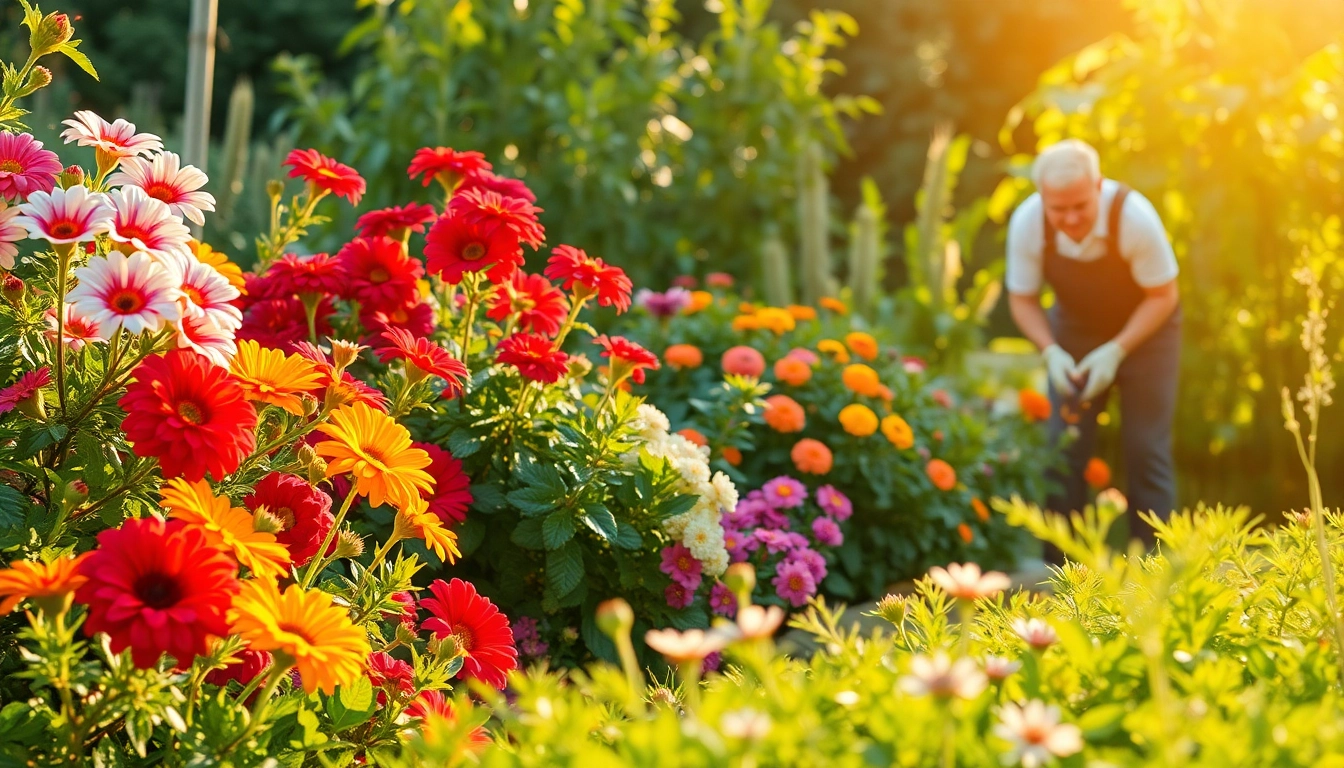Essential Garden Maintenance Tips to Keep Your Outdoor Space Thriving
Fundamentals of Garden Maintenance
A well-maintained garden is not just a visual delight; it reflects the health of the plants and the ecosystem as a whole. Understanding the fundamentals of garden maintenance is crucial for any gardener, whether you’re starting from scratch or rejuvenating a longstanding garden. By focusing on soil health, watering, and basic plant care practices, you can create a thriving environment that supports a variety of plants.
Understanding Soil Health
Soil is the foundation of any garden. Healthy soil provides the nutrients, structure, and moisture essential for plant growth. Here’s how to ensure your soil remains in optimal condition:
- Soil Testing: Periodically test your soil’s pH and nutrient levels. Kits are available at garden centers, and results inform necessary amendments.
- Organic Matter: Incorporate compost and decomposed organic matter, which enriches the soil and supports beneficial microorganisms.
- Crop Rotation: If you’re growing vegetables, practice crop rotation to preserve soil fertility and prevent pests and diseases.
- Soil Aeration: Aerate your soil to improve aeration and drainage, especially in compacted areas.
The Importance of Watering
Watering is crucial for plants, yet it’s often misunderstood. Overwatering can be as detrimental as underwatering. Here are key practices:
- Water Timing: Water your garden early in the morning or late in the evening to reduce evaporation.
- Watering Techniques: Use drip irrigation or soaker hoses to deliver moisture directly to the root zone, minimizing wastage.
- Monitoring: Check soil moisture using your finger or a moisture meter; only water when necessary.
- Irrigation Systems: Consider installing an irrigation system with timers for consistent moisture levels.
Common Plant Care Practices
Effective plant care encompasses more than just watering. To ensure your plants flourish, consider:
- Mulching: Adding mulch helps retain moisture, regulate soil temperature, and suppress weeds.
- Pruning: Regular pruning enhances plant shape, stimulates growth, and removes dead or diseased materials.
- Monitoring for Pests: Early detection of pests and diseases reduces damage. Regularly inspect leaves and stems.
- Fertilizing: Use organic fertilizers to provide necessary nutrients without harming the soil ecosystem.
Spring Gardening Care: Getting Started
Spring is an essential time for rejuvenating your garden as it emerges from winter. With the right approach, you’ll set the foundation for a vibrant garden.
Preparing Your Garden for New Growth
The preparation phase is critical. Here are effective steps to take:
- Clean-Up: Remove debris from the previous year, including dead leaves and weeds, to prevent pests and diseases.
- Soil Improvement: Till the soil and mix in organic matter or compost to enrich it for the new growing season.
- Seed Selection: Choose seeds wisely by considering your climate zone, soil conditions, and the amount of sunlight your garden receives.
- Garden Planning: Plan your planting layout to maximize space, taking into account each plant’s sunlight and nutrient needs.
Essential Spring Tasks for Garden Maintenance
During spring, the following tasks are essential for a healthy garden:
- Fertilization: Apply a balanced organic fertilizer to provide nutrients as plants awaken.
- Seed Sowing: Begin sowing seeds for cool-season crops and transplant hardened seedlings started indoors.
- Weeding: Regularly inspect for weeds, which can compete for nutrients and water. Pull them out while they’re small.
- Mulching: Apply mulch around planted areas to conserve moisture and suppress weed growth.
Choosing the Right Plants for Your Space
The selection of plants is fundamental in garden maintenance. Consider these guidelines:
- Native Plants: Choose native species that thrive in your area and require less maintenance.
- Site Compatibility: Match plants with the correct light, water, and soil needs for the best growth.
- Diversity: Plant a variety of species to promote a balanced ecosystem and attract beneficial wildlife.
- Growth Habits: Understand the mature size of plants to prevent crowding and competition for resources.
Summer Garden Maintenance Practices
As summer heat sets in, maintaining your garden requires vigilance and ongoing effort. Here are strategies to keep your garden flourishing during the hotter months.
Watering Techniques for Hot Months
Summer watering practices must adapt to increasing temperatures:
- Deep Watering: Water deeply and less frequently to encourage deep root growth. Ideal watering depth is 6 to 12 inches.
- Soil Moisture Management: Utilize reminders or schedules to monitor soil moisture levels thoroughly.
- Evaporation Control: Consider using shade cloth for newly planted areas during extremely hot days.
- Well-Planned Schedules: Adjust watering times based on rainfall and humidity levels to avoid over-watering.
Weeding: Best Practices
Weeding ensures your plants receive adequate nutrients and water. Here’s how to effectively manage weeds:
- Regular Inspection: Inspect your garden weekly and remove weeds promptly before they flower and seed.
- Hand Pulling: Use hand tools for early-stage weeds, and ensure you remove the entire root system.
- Weed Barrier Fabrics: Consider using landscaping fabric to minimize weed growth in perennial beds.
- Natural Herbicides: Explore organic herbicides as options for tough weeds while protecting the environment.
Managing Pests and Diseases
Pest and disease management is critical for healthy plants. Strategies include:
- Integrated Pest Management (IPM): Use a combination of biological, cultural, physical, and chemical methods for pest control.
- Beneficial Insects: Introduce beneficial insects like ladybugs to naturally control pest populations.
- Crop Monitoring: Regularly monitor plants for signs of stress, which may indicate pest or disease problems.
- Promptly Handling Issues: Take action quickly when pests or diseases appear. Isolation of affected plants can prevent spread.
Fall Garden Maintenance Essentials
As summer transitions into fall, your garden requires specific attention. Taking fall care seriously prepares your garden for the dormant winter months.
Preparing for Seasonal Changes
Fall preparation is vital to ensure your garden transitions smoothly into winter:
- Final Harvest: Collect the last of the summer crops and prepare them for storage or processing.
- Soil Testing: Take a soil sample and analyze nutrient levels for planning next year’s garden.
- Planting for Spring: Consider planting cover crops in empty beds to enrich soil and prevent erosion.
- Protecting Perennials: Mulch around perennials to protect roots from frost and extreme temperature fluctuations.
Composting for Winter Health
Composting is an excellent way to recycle organic waste and improve soil health:
- Building a Compost Pile: Include kitchen scraps, yard debris, and browns and greens for a balanced pile.
- Winter Care: Turn and monitor your compost pile periodically to ensure effective decomposition throughout winter.
- Using Compost: Plan to incorporate compost into your garden beds in early spring to enrich your soil.
- Education on Methods: Explore various composting methods, including pile, tumbler, or worm composting to find what works best for you.
Winterizing Your Garden
Taking measures to winterize your garden ensures it can withstand frosty conditions:
- Draining Hoses and Tools: Drain irrigation systems and store garden tools properly to maintain them for next year.
- Covering Sensitive Plants: Use frost cloths or mulch to protect sensitive plants during cold spells.
- Equipment Maintenance: Clean and maintain all gardening equipment to ensure longevity and readiness for spring.
- Planning for Spring: Begin planning and making seed selections for the next planting season.
Advanced Garden Maintenance Techniques
For experienced gardeners, advanced techniques can elevate your garden’s health and productivity. Explore these methods to enhance your garden care routine.
Using Mulch Effectively
Mulching is more than simply aesthetics; it serves practical purposes:
- Moisture Retention: Mulch helps retain moisture, reducing the need for frequent watering.
- Soil Temperature Regulation: Applying mulch regulates soil temperature, protecting roots from extreme heat or cold.
- Weed Suppression: A thick layer of mulch (2-3 inches) suppresses weeds effectively without the use of chemicals.
- Composting Benefits: Consider using organic mulches that break down over time, enriching the soil.
Pruning Techniques for Long-term Health
Pruning not only shapes your plants but also promotes their overall health. Here are techniques to consider:
- Timing: Prune trees and shrubs at their optimal times, typically in late winter or early spring before new growth begins.
- Cutting Techniques: Use proper tools, making clean cuts to minimize damage. Aim for 45-degree angles for branches.
- Deadheading: Regularly remove spent flowers to encourage new blooms and prevent the plant from going to seed.
- Thinning: Thin crowded areas to improve air circulation and allow sunlight to reach inner foliage.
Soil Amendments for Improved Growth
Applying soil amendments is crucial for enhancing soil properties and encouraging robust plant health:
- Organic Amendments: Use compost, well-rotted manure, or green manures to enrich soil structure and nutrient levels.
- Mineral Amendments: Incorporate lime or sulfur to adjust pH levels according to the specific needs of your plants.
- Soil Conditioners: Consider gypsum to improve soil structure in heavy clay soils, allowing better drainage.
- Regular Testing: Continually test soil for nutrient levels to inform amendment actions for optimal plant health.



